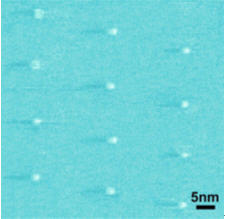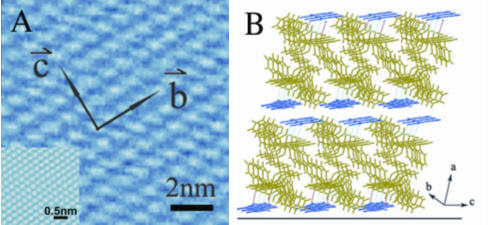| |
Yongqiang Wen, Yanlin Song, Guiyuan Jiang, Dongbo Zhao, Kuiling Ding, Wenfang Yuan, Xiao Lin, Hongjun Gao, Lei Jiang, and Daoben Zhu
(-)-TADDOL and coumarin molecules self-assemble to form crystalline organic films for ultrahigh-density data storage. A 3×4 matrix pattern (see Figure) was recorded between a scanning tunneling microscope tip and the film on a highly ordered pyrolytic graphite substrate. By regulation of the amplitude and width of the applied pulsed voltage, a data storage density of about 1013 bits cm-2 can be achieved.
Adv. Mater. 2004, 16, No.22, 2018-2021

Figure 1. The STM image of a recorded pattern obtained by applying voltage pulses of 3.4 V and 2.3 ms. The scanning area is 70 × 70 nm2. The tunneling conditions were: Vbias = 0.42 V, Iref = 0.62 nA, Scanning rate: 0.2 Hz/image, Scan mode: constant current. The average size of marks is about 2.2 nm in diameter

Figure 2. (A) A typical STM image of TC crystalline thin film, scaning condition: Vbias = 0.36 V, Iref = 0.32 nA; the inset shows the image of HOPG. (B) The stacking arrangement of (-)-Taddol (the green structures) and coumarin molecules (the blue structures) on HOPG substrate in the srystalline film. Dotted lines represent the stabilizing hydrogen bonds between the molecules. From the model, the hydrogen bonding interactions between (-)-Taddol and coumarin molecules, p-p interactions of aromatic rings between coumarin-coumarin and Taddol-Taddol molecules can be clearly observed , |
|
